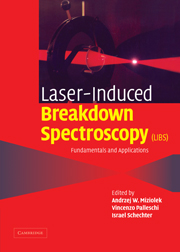Book contents
- Frontmatter
- Contents
- List of contributors
- Preface
- 1 History and fundamentals of LIBS
- 2 Plasma morphology
- 3 From sample to signal in laser-induced breakdown spectroscopy: a complex route to quantitative analysis
- 4 Laser-induced breakdown in gases: experiments and simulation
- 5 Analysis of aerosols by LIBS
- 6 Chemical imaging of surfaces using LIBS
- 7 Biomedical applications of LIBS
- 8 LIBS for the analysis of pharmaceutical materials
- 9 Cultural heritage applications of LIBS
- 10 Civilian and military environmental contamination studies using LIBS
- 11 Industrial applications of LIBS
- 12 Resonance-enhanced LIBS
- 13 Short-pulse LIBS: fundamentals and applications
- 14 High-speed, high-resolution LIBS using diode-pumped solid-state lasers
- 15 Laser-induced breakdown spectroscopy using sequential laser pulses
- 16 Micro LIBS technique
- 17 New spectral detectors for LIBS
- 18 Spark-induced breakdown spectroscopy: a description of an electrically generated LIBS-like process for elemental analysis of airborne particulates and solid samples
- Index
- References
4 - Laser-induced breakdown in gases: experiments and simulation
Published online by Cambridge University Press: 08 August 2009
- Frontmatter
- Contents
- List of contributors
- Preface
- 1 History and fundamentals of LIBS
- 2 Plasma morphology
- 3 From sample to signal in laser-induced breakdown spectroscopy: a complex route to quantitative analysis
- 4 Laser-induced breakdown in gases: experiments and simulation
- 5 Analysis of aerosols by LIBS
- 6 Chemical imaging of surfaces using LIBS
- 7 Biomedical applications of LIBS
- 8 LIBS for the analysis of pharmaceutical materials
- 9 Cultural heritage applications of LIBS
- 10 Civilian and military environmental contamination studies using LIBS
- 11 Industrial applications of LIBS
- 12 Resonance-enhanced LIBS
- 13 Short-pulse LIBS: fundamentals and applications
- 14 High-speed, high-resolution LIBS using diode-pumped solid-state lasers
- 15 Laser-induced breakdown spectroscopy using sequential laser pulses
- 16 Micro LIBS technique
- 17 New spectral detectors for LIBS
- 18 Spark-induced breakdown spectroscopy: a description of an electrically generated LIBS-like process for elemental analysis of airborne particulates and solid samples
- Index
- References
Summary
Introduction
Measurements and simulations of laser-induced optical breakdown spectra are presented in this chapter. Of special interest is the determination of spectroscopic temperature and species concentrations following nominal 1–10 ns laser-induced optical breakdown. Early in the micro-plasma decay, the use of Stark-broadened atomic lines for determination of electron number densities is indicated, and the use of Boltzmann plots is indicated for determination of excitation temperatures. Later in the plasma decay, molecular recombination spectra can be used to characterize the micro-plasma. Spectroscopic temperature and species number densities are inferred by use of the non-equilibrium air radiation (NEQAIR) code. For selected diatomic species that dominate the recombination emission spectrum in the plasma decay, accurate diatomic line strengths are used to find temperature information. The species number densities are estimated from calculated plasma emission spectra for the experimental conditions. Computational fluid dynamics modeling is used to characterize post-breakdown fluid physics phenomena. Laser spark decay phenomena are studied by the use of a two-dimensional, axially symmetric, time-accurate model. The initial laser spark temperature distribution is generated to simulate a post-breakdown profile that is consistent with focal volume investigations. In the developed computational model, plasma equilibrium kinetics are implemented in ionized regions, and non-equilibrium, multi-step, finite-rate reactions are implemented in non-ionized regions.
This chapter addresses simulations of laser focusing, analysis of atomic and molecular spectra, and the computational model to describe laser-induced post-breakdown phenomena.
Information
- Type
- Chapter
- Information
- Laser Induced Breakdown Spectroscopy , pp. 171 - 193Publisher: Cambridge University PressPrint publication year: 2006
References
Accessibility standard: Unknown
- 2
- Cited by
